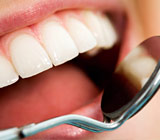Posts for tag: bleeding gums

Did you ever brush your teeth and find that your gums were bleeding slightly? This unwelcome discovery is more common than you might think — and it might have something to tell you about your oral health. Here are five things you should know about bleeding gums.
- As much as 90% of the population occasionally experiences bleeding gums. It happens most often while brushing — and it’s often a sign of trouble, indicating that your gums are inflamed and/or you aren’t brushing or flossing optimally.
- Bleeding gums can be an early warning sign of gum disease. In its earliest stages, this malady is called gingivitis, and it’s quite common. About 10 to 15 percent of people with gingivitis go on to develop a more serious form of gum disease, called periodontitis. If left untreated, it can lead to gum recession, bone loss, and eventually tooth loss.
- A professional exam is the best way to tell if you have gum disease. Your dentist or hygienist may use a small hand-held instrument called a periodontal probe to check the spaces between your teeth and gums. When gum tissue becomes detached from the teeth, and when it bleeds while being probed, gum disease is suspected.
- Other symptoms can confirm the presence of gum disease. These include the presence of pus and the formation of deep “pockets” under the gums, where gum tissues have separated from teeth. The pockets may harbor harmful bacteria, and need to be treated before they cause more damage.
- Several factors may influence the health of your gums. How effectively you brush and floss has a major impact on the health of your gums. But other factors are important too: For instance, women who are pregnant or taking birth control pills sometimes have bleeding gums due to higher hormone levels. Diabetics and people with compromised immune systems often tend to have worse problems with periodontal disease. Certain drugs, like aspirin and Coumadin, may cause increased bleeding; smoking, by contrast, can mask the presence of gum disease by restricting blood flow.
It’s never “normal” to have bleeding gums — so if you notice this problem, be sure to have an examination as soon as you can. If you have questions about bleeding gums or periodontal disease, contact us or schedule a consultation. You can read more in the Dear Doctor magazine article “Assessing Risk For Gum Disease.”

Being “in the pink” is a good thing; it means you're healthy. Being “in the red” is not so good; it means your health is questionable (financially, anyway). Though they weren't coined for dentistry per se, these colorful expressions are helpful reminders when it comes to taking care of your gums: Pink is their natural, healthy color; that's what you want to see every time you look in the mirror. Red is generally a warning that something's amiss.
If your gums, or “gingiva,” appear slightly swollen and reddened at the margins and/or they bleed when lightly prodded by brushing or flossing, it's likely that you have gingivitis. This is an immune response to the buildup of bacterial plaque (biofilm) at your gum line. It is also an early red flag for periodontal disease (peri – around, odont – tooth), a degenerative process that affects not only the gums, but the periodontal ligament that attaches each tooth in its bony socket, and the underlying supporting bone.
Attentive home dental hygiene practices prevent most plaque buildup from occurring. Brushing correctly at the gum line is a good start. But even a deftly handled brush can't reach everywhere, so it's important to use dental floss or specially designed mini-brushes to get in between teeth and other hard-to-reach areas. Our office can instruct you on optimal home care techniques. We also encourage you to visit at regular intervals for professional cleanings so you are assured of addressing anything home care might miss.
In the absence of good oral hygiene, dental plaque can build and become increasingly difficult to remove as it calcifies, becoming tartar. It becomes a breeding ground for disease-causing microbes that normally wouldn't have the chance to gain a foothold. When caught early, gingivitis can be treated before any harm is done. Sometimes a thorough professional cleaning is sufficient. If the problem is ignored, however, the disease will most certainly progress to destruction of the surrounding, supporting tissues — the periodontal ligament and the underlying bone. If this happens, tooth loss could eventually result.
That said, there can be other causes for bleeding gums. These include:
- Brushing too rigorously or using a toothbrush with bristles that are too firm
- Side effect of a medication
- In women, elevated hormone levels (e.g., birth control pills or pregnancy)
- A systemic (bodily) disease
Whatever the reason, red is not normal when it comes to your gums. The sooner you discover the underlying reason(s) for inflammation or bleeding and take appropriate action, you and your smile will be back in the pink and you'll have no reason to be blue!
If you would like more information about preventing or treating bleeding gums, please contact us or schedule an appointment for a consultation. You can also learn more about this topic by reading the Dear Doctor magazine article “Bleeding Gums.”
